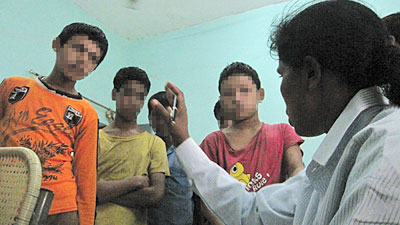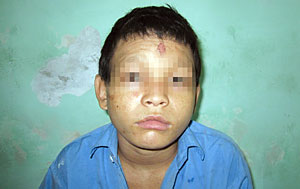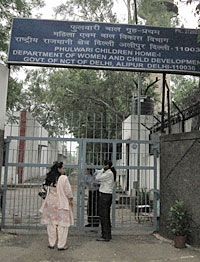 ESTHER BENJAMINS MEMORIAL FOUNDATION GHAR KAHA? Shailaja CM, Director of EBMF questions the children at Phulbari Children's Home in Delhi, collecting information to trace their parents and homes. |
Fourteen-year-old Pralad Rai is scrawling the numbers 1-100 in a new exercise book he has just been given. "Thik hai?", he asks in Hindi, a language he acquired while living in India for a year. His forehead is scarred; there are marks on his cheeks, neck and feet and bruises on his body. It makes you wonder what kind of life he must have lived
in India.
Pralad is one of thousands of children who reach India for work but end up in government-run children's homes. On 23 August, he arrived in Kathmandu along with six other boys, in the aftermath of a successful rescue operation overseen by Esther Benjamins Memorial Foundation (EBMF). While Pralad had been trafficked, the rest had run away from home to find work.
 They used to make us squat in the 'chicken' position while they beat us. I was even knocked unconscious once for taking some food for a friend. This scar on my forehead? They banged my head against the wall." Pralad Rai, rescued from a children's home in Delhi |
"Poor financial status and difficult family lives push these children to leave home," says Durga Ghimire of ABC Nepal. While there are no records of Nepali child labourers in India, it is estimated that every year 4,000-5,000 Nepali children cross the border hoping to find work and a better life. This makes them vulnerable to trafficking. These children find jobs in restaurants, small factories, circuses and in homes, as domestic help. Workplace abuse is rampant, which means many of these children end up on the streets.
Child-based organisations and the police pick up street children from railway stations, bus stations and the places where they work, and present them to the Child Welfare Committee (CWC). The CWC then allocates them to Juvenile Justice Homes, commonly known as children's homes or observation homes. "As private children's homes are reluctant to accept Nepali children, they are compelled to go to government-run observation homes," says Shailaja CM, Director of EBMF.
Most of these government-run homes barely pass the minimum standards of a children's home (see box). There are 600 such homes and they house not just street children but minors convicted of crime. Special permission is required for an outsider to enter these homes and cameras are prohibited. As the children themselves are not allowed to leave the homes of their own free will, their plight is a largely invisible one.
 |
However, bringing them back is not the end of the story; it's as important to reunite the children with their families and ensure they have a better future. "Most often the children require counselling before they can go back," says Bharat Adhikari of CWIN. Some children are reluctant to return home and often the organisation involved takes on the responsibility of rehabilitating them.
There are still many Nepali kids in such homes in India, and an estimated 500 in Delhi alone. "Bilateral mechanisms have to be put in place so that there is proper networking," says Gauri Pradhan of the National Human Rights Commission. "If the police, child-based organisations, and the embassy work effectively together, we can bring our children home."
The children's names have been changed
Inside story
 |
The lack of infrastructure could be excused if the children were treated well. But they suffer physical and sometimes even sexual abuse from other children and supervisors. "They used to hit us on our legs and feet for even a small mistake," says 17-year-old Ashim Nepal.
The children went to school for three hours a day, where they were also taught to use computers. "But we didn't have study hours at the government home, we played and had to scrub the floors more than three times a day," says 15-year-old Shyam Gupta. Running away was not an option as the compound was heavily guarded and the walls were topped with electrified wires.
READ ALSO:
The disappeared and the disquiet of those left behind, ROBERT GODDEN


